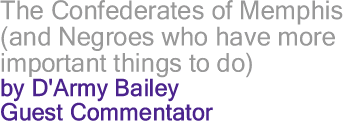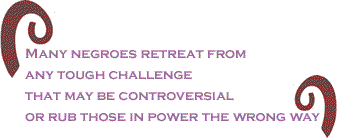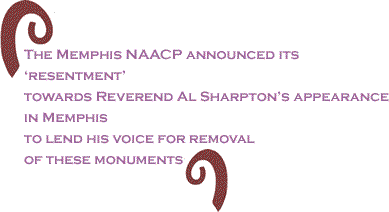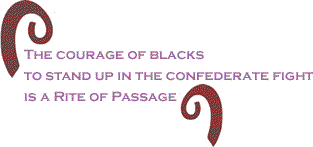
|
|||||||||||||||||||||
|
|
The tragedy of Hurricane Katrina is the most overwhelming picture among a myriad of realities that define blacks' relative powerlessness in America. On the other end of the seriousness scale is the slap in the face to southern blacks whose local governments continue to fund public tributes to confederate leaders of the Civil War who ruthlessly plundered lives in their fight to keep blacks enslaved. Memphis, with a 62 percent African-American population and home to the highest proportion of metropolitan blacks in the nation, now joins other southern cities in a bitterly divided battle over whether the city should continue funding parks and monuments honoring the confederacy and its leaders. The conflict pits a determined group of black leaders and activists fighting to change the parks, against the city's black Mayor Willie Herenton, the Sons of Confederate Veterans, their sympathizers and an assortment of white supremacists. Sitting silently on their hands in this acrimonious controversy are Memphis' corporate and religious leaders, and moderate blacks who say leave the parks as they are. The controversy arose last spring when a quasi-governmental group, the Memphis Center City Commission, created a study committee to assess whether the city should continue to maintain public confederacy tributes. The parks at issue are Nathan Bedford Forrest, Jefferson Davis, and Confederate Parks, all located downtown and at the city's doorstep. Forrest was a notorious slave trader, Civil War General and first Grand Wizard of the Ku Klux Klan. Davis was President of the Confederacy and jailed for two years after the war.
Forrest and his wife's remains were disinterred from the family burial plot in Elmwood Cemetery in Memphis. Forrest had chosen that final resting place in his will, expressing a desire to rest eternally among the scores of confederate veterans buried at Elmwood. He and his wife were reburied in the public park in 1905 in a celebration attended by thousands of white Memphians. Today, Forrest Park is the site of an annual celebration by the Sons of Confederate Veterans. This year’s celebration was scheduled to feature a minstrel show, but the event was abruptly cancelled when the media learned of it. To properly understand the significance of these Confederate tributes, one must consider these monuments in the context of the social attitudes and tolerances during the times they were put in place. The first of these memorials was dedicated in 1899; thirty-four years after the South lost the Civil War. The last was put up in 1930. During these times, white men ruled Memphis, racism was open and rampant, and blacks’ input was considered insignificant at best and insolence punishable by death at worst. The confederate parks controversy has special meaning in Memphis. Black Memphians have for the most part not been as aggressive as in other cities in challenging the largely white, affluent power structure. Raising the consciousness level to where enough blacks can grasp the significance of this battle has been a formidable task. Movements for social change rarely start with the support of the overall majority, or even with the support of the majority of those for whom the movement was organized to help. In the sixties the efforts of students and other anti-segregation activists were dismissed by many blacks and openly criticized by black leaders and preachers. Now the children of those critics and cynics enjoy the fruits of the civil rights struggles of the few, as they bask obliviously complacent in their newfound freedoms, comfortable homes, political positions and nice paying jobs. The park struggle in Memphis has been met with a similar 1960’s style cynicism and hostility from many negroes, afraid of rocking the boat or having anyone else rock it. They say, "I've got more important things to do." At the same time they retreat from any other tough challenge that may be controversial or rub those in power the wrong way. And even if they were working on some other project, their one-dimensionality would not justify deriding and hindering those who are trying to remove these confederate relics of the past. The "unimportant" issue of the parks has generated numerous public statements, a mayoral press conference, two government legal opinions, and two full-page newspaper advertisements attacking the effort to remove the symbols. The issue is important enough to the white supremacist Council of Concerned Citizens’ that they have highlighted it on their racially-charged website. The racist infiltrated Sons of Conservative Veterans made a national pledge of an initial ten thousand dollars to the fight to preserve the park symbols in Memphis.
Outside of Memphis the NAACP has been a leader in the fight to remove confederate symbols and flags. NAACP National Chairman Julian Bond likened the argument that the citizens of Memphis have more important issues to deal with to the charge during the civil rights movement that, instead of fighting to eat next to whites in restaurants, blacks should focus on the more important issue of earning money to pay for the food. By contrast, the Memphis NAACP announced its "resentment" towards Reverend Al Sharpton’s appearance in Memphis to lend his voice for removal of these monuments. And in a blast in the Memphis newspaper, black Mayor Herenton indignantly stated, "[t]he fact that Rev. Al Sharpton has been invited to Memphis serves no useful purpose as far as I'm concerned. All Sharpton can do is come and run his mouth... As mayor, I don't give a damn about Al Sharpton." Dr. Martin Luther King addressed this type attack on civil rights leaders coming from outside to help in his Letter from a Birmingham Jail:
What appears to frighten people
is not that the parks issues is not important, but rather that
keeping these parks
and monuments is ‘too important’ to the Neo-Confederates and Rebel
flag wavers for whom the cause of the Confederacy is still dear
to their hearts. The controversy has generated insulting and malicious
sentiments in public meetings and in steady streams of letters
to the morning newspaper.
The Ku Klux Klan and other white supremacists have threatened violent action in Memphis if the parks are altered. This has intimidated key local leaders who worry that this maliciousness will give the city a black eye in other parts of the country. So they claim the issue is "raciallly divisive." Dr. King addressed a similar "racially divisive" criticism in his Birmingham letter:
Today many of our cities are racial powder kegs ready to explode with the most random incident. These internalized tensions are nurtured by the timidity and failure of black leaders to push affirmative remedies, which they fear may draw disfavor among powerful segments of the white community. That so many citizens of all colors in Memphis want to pretend that there is no racial problem makes things even worse. Black Memphians have, for the most part, the poorest education, worst healthcare and the least economic independence in a state which is itself amongst the poorest in the country.
The racial underpinnings of these problems are documented in Ira Katznelson's new book, When Affirmative Action Was White. The book examines how powerful southern Congressmen incorporated the framework for racial discrimination into a number of the important federal social programs of the 1930’s and 40’s, including the G.I. Bill of Rights. By design, these programs excluded agricultural and domestic workers from the right to receive minimum wage. Southern officials were given the authority to unfairly deny blacks housing and business loans and access to more competitive colleges and universities. Blacks were systematically channeled into low paying jobs rather than given an opportunity to participate in federal job training programs for skilled vocational and technical jobs. The fear of dealing with the hostile racial attitudes of those that insist on keeping these Confederate monuments is a reflection of the docile attitude that too many black Memphians have. The courage of blacks to stand up in the confederate fight is a Rite of Passage. Al Sharpton put it succinctly:
Black organizations and leaders in other parts of the south have stepped forward to retire the symbols that celebrate and honor the Confederacy. It didn't take the new black mayor of Selma, Alabama long to remove a statue of Nathan Bedford Forrest from public land to a cemetery. Many progressive southern cities do not have confederate parks and rebel monuments. If blacks in Memphis can't confront the most elemental insult by stopping this publicly sponsored glorification of the confederacy, they are not likely to have the backbone to eyeball the white man with even more serious challenges. The Honorable D’Army Bailey is an activist, politician, attorney, writer, columnist and actor who became a jurist in 1990, when he was elected Circuit Court Judge in Tennessee's 30th Judicial District. Reelected in 1998, Judge Bailey continues to devote himself to the fight for civil rights. Bailey is an author, guest speaker for universities and civic organizations, and has been seen in the films The People vs. Larry Flynt, How Stella Got Her Groove Back and Mystery Train. |
|
| Home | |
Your comments are always welcome. Visit the Contact Us page to send e-Mail or Feedback or Click here to send e-Mail to [email protected] e-Mail re-print notice
If you send us an e-Mail message we may publish all or part of it, unless you tell us it is not for publication. You may also request that we withhold your name. Thank you very much for your readership. |
|
| October20 2005 Issue 155 |
|||||||||
|
|||||||||
|
|
|||||||||
| Printer Friendly Version in Plain Text or PDF format. Download free Adobe Reader. | |||||||||
 |
|||||||||
 |
|||||||||
| |
|||||||||
| |
|||||||||





























